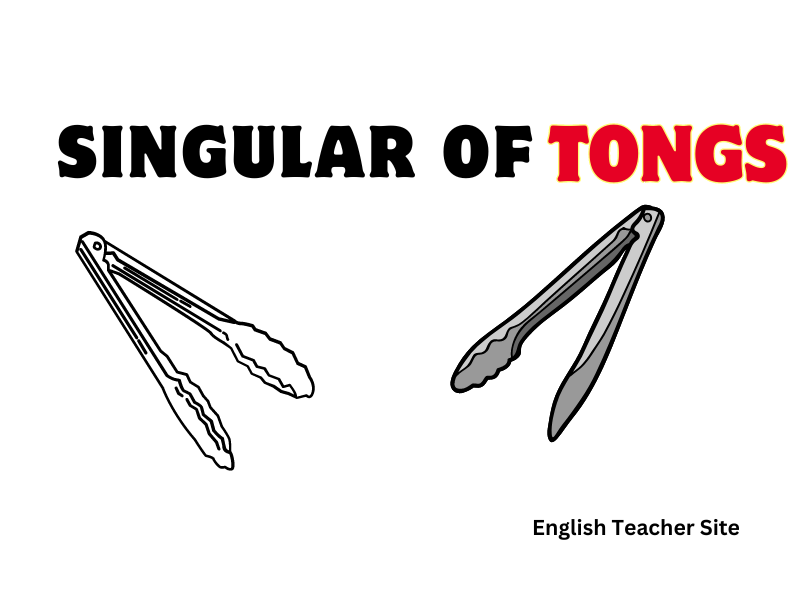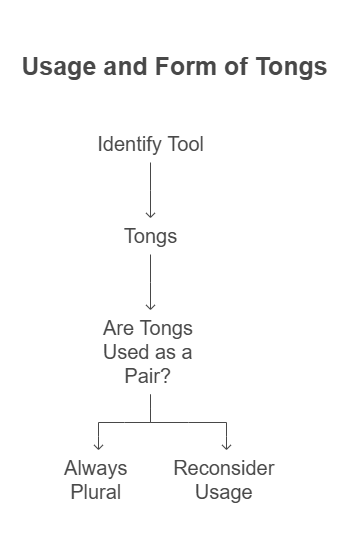Singular of Tongs: The Answer That Surprises Everyone

Why the Singular of Tongs Is a Question Worth Asking
It’s easy to overlook the words we use for familiar objects. Yet, now and then, curiosity strikes. Why do we say tongs instead of a tong? And if you’re holding just one, what exactly do you call it? These small linguistic puzzles reveal fascinating quirks about how language evolves and how we label the items we use daily.
Understanding Plural-Only Nouns
What Are Pluralia Tantum and Why They Matter
Pluralia tantum is a Latin term for nouns that exist only in the plural form. These words refer to objects that are inherently made up of two joined parts or are perceived as a single entity despite their duality. This linguistic category adds complexity and nuance to English, making it rich but occasionally perplexing.
Why Tongs Falls Into This Unique Category
Tongs follow this pattern because they typically consist of two arms joined at a pivot point. The tool functions because of its two-part structure, so the language naturally treats it as plural. It’s a practical description that evolved into a grammatical rule.
Is There a Singular of Tongs?
The Straight Answer That Surprises Most People
No, there is no true singular form of tongs in English. You don’t say a tong to refer to one implement. Tongs functions as a singular object described in plural form, much like scissors or pants.
Attempts to Create a Singular Form
Occasionally, people try to back-form a singular noun, calling one part of tongs a tong. But this usage is informal and rarely seen in standard dictionaries or formal writing. It feels awkward because it breaks established linguistic norms.
Why Singular Forms Sometimes Don’t Exist
Instruments with dual parts often lack a singular form because their function depends on both halves working together. Without one side, the tool loses its purpose. Therefore, there’s little linguistic motivation to coin a singular counterpart.
When Singular Concepts of Tongs Appear
Describing One Side or Arm of the Tool
In technical discussions, you might hear references to one arm of the tongs. However, this is descriptive rather than grammatical. It specifies part of the tool, not an alternative singular noun.
Referring to Tongs as a Single Unit
Despite its plural appearance, tongs is treated as a singular object. You’d say, “The tongs is on the table,” in American English, recognizing it as one item.
Singular Descriptions in Manufacturing and Design
In manufacturing, designers may refer to a piece of tongs or a tool rather than using the word tong. Technical manuals focus on function and parts but continue to uphold the plural naming convention.

Common Misunderstandings About Tongs
Why Saying a Tong Feels Wrong
A tong feels linguistically out of place because it misrepresents the tool’s dual-part nature. The English ear expects plural phrasing for such items, making the singular form sound unnatural.
Everyday Language vs Technical Descriptions
In casual speech, people sometimes experiment with a tong, but in professional or technical language, this is avoided. Precision and convention dominate formal usage.
The Risk of Overthinking the Singular Form
Overanalyzing the grammar can lead to clumsy phrasing. It’s often best to follow established usage rather than inventing forms that confuse readers or listeners.
Alternatives and Workarounds
Phrasing That Works in Everyday Conversation
When clarity is key, refer to a pair of tongs. This familiar phrase sidesteps confusion and conforms to common usage.
Using Tool or Utensil as a General Term
When necessary, call it a tool or a utensil. This simplifies communication, especially in contexts where technical specificity isn’t required.
How Professionals Refer to a Single Tongs Tool
Professionals often stick to a pair of tongs or the tongs. Rarely do they attempt to reengineer the word itself, opting for clarity over creativity.
Fun Facts and Trivia About Tongs
Oddities in the Language of Tools
Tongs is part of a broader category of tools that have defied singularization for centuries. Its unique linguistic status makes it an entertaining example for language enthusiasts.
Cultural Differences in Naming Utensils
Different languages handle this concept differently. Some use singular terms for similar tools, while others adopt plural constructions like English.
Quirky Uses of the Word Tongs Through History
In medieval times, tongs were so important they were often listed in wills and inventories. Their presence signaled wealth and craftsmanship, and the word itself carried weight.
Practice and Usage Tips
How to Refer to Tongs in Writing Without Confusion
Use a pair of tongs for singular references and several pairs of tongs for plural. Stay consistent, and be mindful of your audience’s expectations.
Example Sentences That Keep Things Clear
- The chef reached for the tongs beside the stove.
- She bought a pair of tongs for the barbecue.
- The blacksmith’s tongs were heavy and well-worn.
Best Practices for Professional and Casual Contexts
In formal writing, avoid inventing a singular. In casual conversation, feel free to explain your choice, but default to standard usage for clarity.
Conclusion
The Final Word on the Singular of Tongs
There is no singular form of tongs in standard English. It’s a plural-only noun that represents a single tool composed of two parts.
Key Takeaways for Writers and Speakers
- Tongs is always plural in form.
- Use a pair of tongs when needed.
- Avoid coining a tong in formal contexts.
Why Language Evolves but Some Rules Stick
Language changes, but some conventions persist because they offer clarity and consistency. Tongs is a reminder of how language reflects both history and practicality.
Embracing the Complexity of Everyday Words
Even simple objects hide complex linguistic stories. Understanding these nuances enriches communication and deepens our appreciation for language itself.
Sources
My name is Khamis Maiouf. I am the creator of the English Teacher Site, dedicated to providing valuable resources and insights for students around the world. With a passion for education and a commitment to helping students enhance their skills, I aim to make English teaching more effective and enjoyable for both educators and students.






